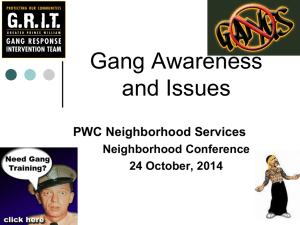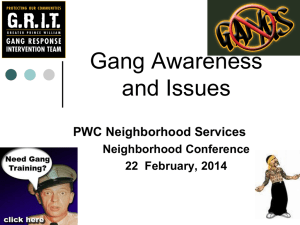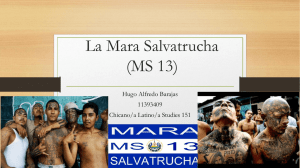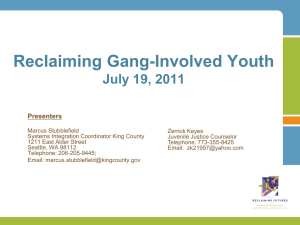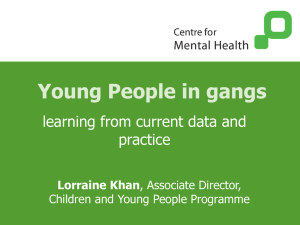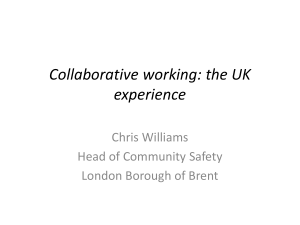US Hispanic/Latino Street Gangs
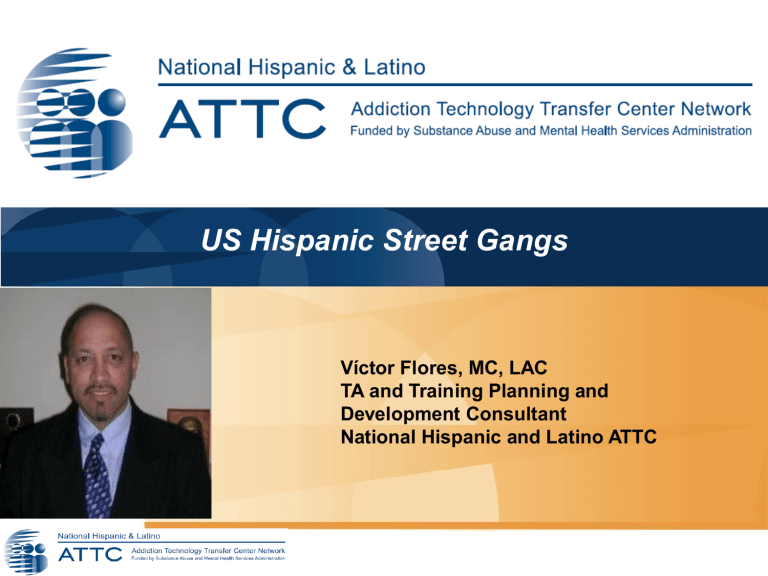
US Hispanic Street Gangs
Víctor Flores, MC, LAC
TA and Training Planning and
Development Consultant
National Hispanic and Latino ATTC
U.S. Hispanic/Latino Street Gangs
• Brief overview of a SAMHSA training manual/curriculum
• Developed by the National Hispanic & Latino
ATTC
• Community Based Manual – Dr. Valdez
• Transformed into a Training Curriculum
• Rolled out in regions associated with the ATTC across the U.S. - Arizona, California, Florida,
Illinois, Maryland, Massachusetts, New Mexico and Texas
How is this related to what we do?
• The author of the curriculum indicates that despite difficulty in tracking data with gang-involved youth, qualitative research about substance use among gang youth is important because research indicates that such youth use more substances than their non-gang peers.
• The original guide is written to be useful for community practitioners in order to orient themselves to the multiple and complex problems associated with street gangs. This guide also aims to be helpful in the development of effective prevention and intervention programs that are culturally relevant and meet the needs of this rapidly growing minority population.
• The author also has conducted studies where data indicates that drug use interacts with an individual gang member’s risk for violence to affect violent behavior outcomes.
U.S. Hispanic/Latino Street Gangs
Definition of a Gang
The definition of a street youth gang has been characterized as a identifiable group of youngsters who:
(a)are generally perceived as a distinct aggregation by others
(b)recognize themselves as an street identifiable group (almost invariably with a group name)
(Reference: Klein 1971; Klein and Maxson 2006)
4
U.S. Hispanic/Latino Street Gangs
Definition of a Gang
(c) have been involved in a sufficient number of delinquent incidents to call forth a consistent negative response from neighborhood residents and/or law enforcement agencies.
(Reference: Klein 1971; Klein and Maxson 2006)
5
U.S. Hispanic/Latino Street Gangs
Identifying Street Gangs
Identifying gang members on the street can be challenging.
Law enforcement, educational institutions, and social service agencies and others use varying characteristics in defining and identifying gangs and gang members.
Hispanic/Latino youth often are mistaken for gang members.
For Hispanic/ Latino youth, this creates atmosphere of fear and intimidation.
6
U.S. Hispanic/Latino Street Gangs
Racial and Ethnic Group Gangs
Most gangs tend to be racially and ethnically homogenous
Ethnic minority gangs emerge in communities with high unemployment, poverty, welfare dependency, single headed households and other socioeconomic characteristics.
Hispanic/Latino racial and ethnic group gangs reflect differences in region, economic situation, social status, immigration status, generations and cultural characteristics.
(Reference: Starbuck, Howell, & Lindquist, 2001)
7
U.S. Hispanic/Latino Street Gangs
Overview of Hispanic/Latino Gangs
One of the most important dimensions in considering the different types of Hispanic/Latino gangs is ethnicity.
Mexican American Gangs
• Southwest/Border region
• Multi-generational
“cholo” family based
• Neighborhood/Territorial based networks
Puerto Rican Gangs
• Northeastern / Midwest region
• Urban areas experienced de-industrialization
• Circular Migration
(Mainland – Island)
Central American Gangs
• Southwest (LA, Houston)
/ East Coast
• Multiethnic Urban/
Suburban regions
• Transnational Activity
8
U.S. Hispanic/Latino Street Gangs
Differences in Hispanic Street Gangs
Stereotypical images and stories abound in the public media.
Street gangs engage in fighting for various reasons such as territory, prestige, honor, and females. Their violence may largely be related to expressive reasons.
Drug gangs are characterized by their engagement in drug dealing and trafficking. Their violence is basically related to instrumental functions such as enforcement of market advantages and the collection of debts.
9
U.S. Hispanic/Latino Street Gangs
Understanding Variations in Hispanic/Latino Gangs
According to Valdez (2006) gangs vary in their composition on five key characteristics:
Illegal
Activities
Drug Use
Patterns
Violent
Behavior
Adult
Influences
Gang
Organization
10
U.S. Hispanic/Latino Street Gangs
Prison Gangs and Hispanic/Latino Street Gangs
Traditionally, youth street gang and the prison gang have been quite separate entities.
Street gang members are perceived as too emotional and undisciplined to warrant recruitment by a prison gang until they were incarcerated.
Even when incarcerated, street gang members tended to sustain their identification with their gangs and even resist prison gangs by keeping true to their geographical loyalties and animosities.
11
U.S. Hispanic/Latino Street Gangs
Prison Gangs and Hispanic/Latino Street Gangs
As more and more gang members are incarcerated the traditional relationships between prison and youth street gangs is changing.
The alliance of youth street gangs and prison gangs is exacerbated by formerly incarcerated Hispanic/Latinos returning to their communities.
12
U.S. Hispanic/Latino Street Gangs
Hispanic Gang Members Demographics
Gender: Hispanic gang members, as with other ethnic groups, are predominantly males. The percentage of youth selfidentifying as gang members who are female has been reported to range from 8 to 38 percent.
Age: The trend on age distribution among gangs has been changing from 1996 through 2000. In 1996 there was an even split in gangs between juveniles (i.e., under 18) and young adults
(over 18). By 1999, the percentage of young adults had risen to
63 percent. For Hispanic gangs, these distributions seem to be similar.
13
U.S. Hispanic/Latino Street Gangs
Hispanic Gang Members Demographics
Urban versus Suburb: Hispanic/Latino gangs have been largely an urban phenomenon until recently; are now spreading from larger cities to suburban areas at seemingly the same proportion as the national averages.
Migration: The increasing migration of Hispanic gang members that follow the pathways. The general Hispanic/Latino population in the U.S. is also changing the traditional concentration of
Hispanic gangs in specific regions of the country.
(Reference: Vigil, 2001)
14
U.S. Hispanic/Latino Street Gangs
Social Profile of Hispanic Gang Members
Criminal Behavior: Gang members, in contrast to other delinquent youth, engage in exceptionally high levels of criminally-related behavior. Gang members report participation in various other criminal activities including drug selling and dealing, burglary, auto theft, car-jacking, robbery, fencing, and weapon sales.
Drug Use: Gang members engage in exceptionally high levels of lifetime and current use of illicit drugs compared to other youth.
(Reference: Valdez, 2003)
15
U.S. Hispanic/Latino Street Gangs
Substance Use Patterns
• High rates of lifetime and current use
• Study on San Antonio gangs
– Marihuana: 98% lifetime 75% current
– Cocaine: 90% lifetime 53% current
– Heroin: 57% lifetime 26% current
– Prescription pills (Rohypnol, Valium and Xanax): 75% lifetime 28% current
Source: Valdez, 2003
U.S. Hispanic/Latino Street Gangs
Substance use patterns
• Youth gang involvement in drug use higher than nongang members
• Hispanic adolescents involved in gangs shown to have high prevalence rates of drug use
• Polydrug use problem among Hispanic gang members
• Studies where Hispanic gang members use more addictive substances like cocaine and heroin
• Hispanic females associated with gangs more likely to be involved in legal and illegal substance use than other delinquent females.
• Drug selling and dealing may be common (less organized)
U.S. Hispanic/Latino Street Gangs
Social Profile of Hispanic Gang Members
School Dropout: School dropout rates among gang members are disproportionately high when compared to other youth.
These rates are a direct consequence of the “precocious transitions”- untimely and disorderly life course transitions.
18
U.S. Hispanic/Latino Street Gangs
Young Females and Male Gang Members
While males are typically self-identified gang members, females are distinct in that they are integrated into gang life through various affiliations, other than being a gang member (Valdez,
2007).
Some distinct types of women associated with gangs are:
Girlfriends (wives, sweethearts)
Good Girls
(sisters, relatives, childhood friends)
Relatives
(sisters, cousins)
Hood Rats
(party girls, sluts, bad girls)
19
U.S. Hispanic/Latino Street Gangs
Gangs in Your Community
The following are community characteristics associated with the emergence of gangs in Hispanic/Latino neighborhoods:
20
U.S. Hispanic/Latino Street Gangs
Who is Likely to Join a Gang?
There is no single explanation as to why Hispanic/Latino adolescents join gangs or why some adolescents do not join.
Multiple factors are continually interacting with each other to exert influence on an individual’s susceptibility for gang involvement.
Features that promote participation in youth gangs are known as risk factors that may increase the probability of an adolescent joining a gang.
21
U.S. Hispanic/Latino Street Gangs
Who is Likely to Join a Gang?
Gang membership is associated with prestige or status among friends, excitement, and personal economic advantages.
In marginal communities joining a gang provides them with a sense of protection and identity.
22
U.S. Hispanic/Latino Street Gangs
Who is Likely to Join a Gang?
Risk factors associated with adolescents joining
Hispanic/Latino gangs are organized into five categories adapted from the ecological framework:
Individual
Family
Peer
School
Community Influence
Source: Adapted Ecological Framework for Risk Factors Associated with Hispanic/Latino Adolescent Gang Membership (National Youth
Violence Prevention Center, 2005).
23
U.S. Hispanic/Latino Street Gangs
Warning Signs of Gang Membership
No single indicator of gang involvement in adolescents but rather a multiplicity of warning signs. Potential warnings signs:
Increased conflict with family members (i.e., curfew violation, lack of communication)
Changes in behavior
Changes in attitudes about school
Discipline problems at school including lower grades
Changes in style of dress
Suspected drug and alcohol use
Increase in material possessions and cash
24
U.S. Hispanic/Latino Street Gangs
What Strategy Works Best to Address
Gang Problems?
The current consensus of informed opinion holds that there is no single strategy or easy solution for Hispanic/Latino gang problems.
A promising approach is to think of different strategies that can be combined in meaningful ways.
Drug using behavior and the attachment to the gang can be significantly reduced by evidenced based and culturally relevant interventions.
25
U.S. Hispanic/Latino Street Gangs
What Strategy Works Best to Address
Gang Problems?
Comprehensive community mobilization strategies involving the participation of broad-based community coalitions ranging from the police and prosecutors to street outreach workers.
In order to be effective strategies needs to offer enhanced options to incarceration and probation; including employmenttraining programs in either after care or alternative sentencing forms as well as integrated substance abuse and mental health services.
26
U.S. Hispanic/Latino Street Gangs
Spectrum of Youth Street Gangs
Criminal Zone
Drift Zone
Normal Zone
Criminal Gang
Traditional Gang
Delinquent Youths
Troublesome Youths
Mildly Deviant Youths
Normal Youths
(Source: Kaplan et al., 2010).
27
U.S. Hispanic/Latino Street Gangs
Working with Gangs
Encompasses various approaches in conducting outreach with gangs.
Before going into the field and contacting youth, individuals need to be aware of several important factors that will assist in developing positive relationships with these adolescents.
Attention needs to be given to specifying gang member status and gang organizational types.
28
U.S. Hispanic/Latino Street Gangs
Competencies to Work with Hispanic/Latino
Gangs
Ineffective attempts of working with gang members comes from:
Lack of distance leading to an unconscious reinforcement of gang behaviors.
Having too far a distance leading to a loss of perspective on the needs of the gang members.
This form of incompetence is often tied to a lack of cultural relevance and sensitivity.
29
U.S. Hispanic/Latino Street Gangs
Competencies to Work with Hispanic/Latino
Gangs
Basic understanding of cultural prerequisites such as familismo, Respeto and colectivismo is necessary, but also more refined sensitivity is required.
An appreciation of local idioms and mores tied to
Hispanic/Latino subcultures is necessary—and ability to be non-judgmental.
Skills related to negotiation, conflict resolution and mediation between gangs, their members, families, schools, and community agencies are essential.
30
U.S. Hispanic/Latino Street Gangs
Skills and Approaches to Working with Gangs
Acquiring Extensive Information on Gangs
First step is to broaden the base of prior knowledge by learning as much as possible regarding the types of members, cliques, and ranges of gang activities.
Step must be initiated by recognizing any prior bias or preconceived opinions about this population.
These socially marginal groups have “low social visibility” often due to stigmatized or illegal behaviors and as such, are difficult to locate.
31
U.S. Hispanic/Latino Street Gangs
Recognize the Signs
Gangs and gang related activities impact everyone in the community. Gang members communicate in many different ways:
Speech is the most obvious; however, gang members also make use of nonverbal methods of exchanging thoughts. Graffiti, hand signs, colors, and tattoos are indicators of gang affiliation.
Gang members have their own language, which contains phrases, hand signs, tattoos, markings, and graffiti.
32
U.S. Hispanic/Latino Street Gangs
Recognize the Signs
These often overlap. As an outsider, you may not recognize them right away. It is critical you understand the reasons for joining a gang and recognize the signs of gang involvement.
General signs:
Admits membership
Change of behavior/defiant behavior
Grades drop/truancy
New friends
Slang
Obsession with colors/sports apparel
Flashing signs
Graffiti on books and walls
Calls from unknown people Nicknames and street names
Unexplained money and jewelry Evidence of drug use
Source: www.njgangfree.org
33
Questions

